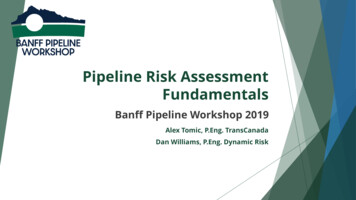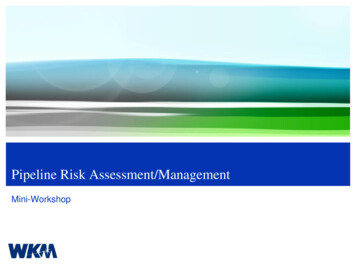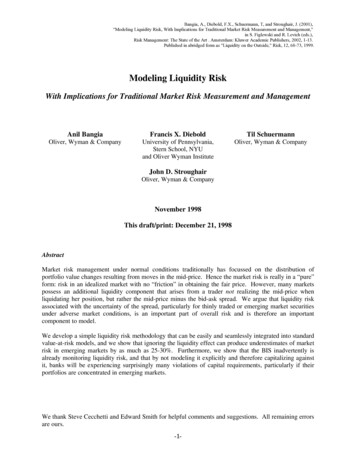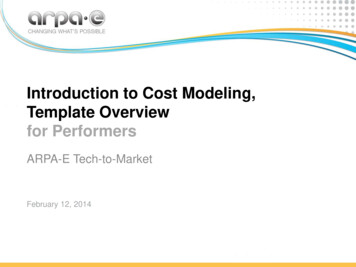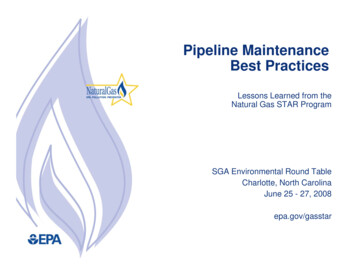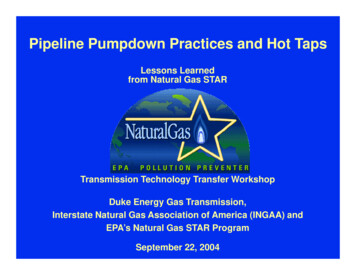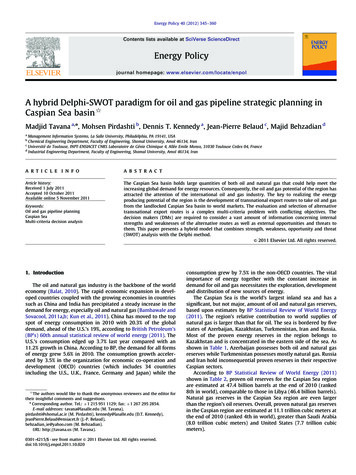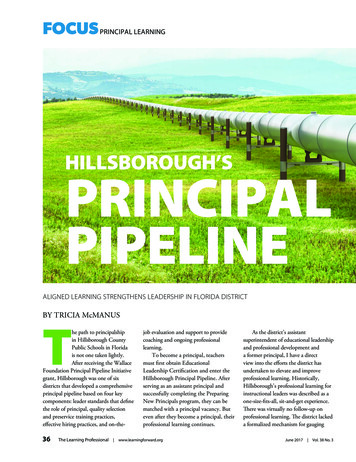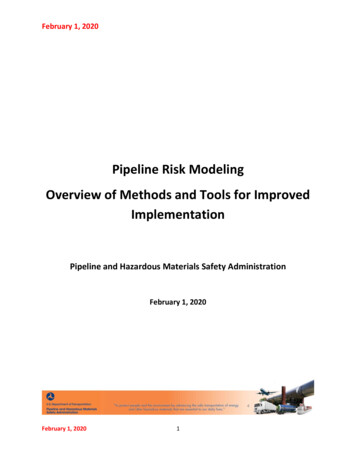
Transcription
February 1, 2020Pipeline Risk ModelingOverview of Methods and Tools for ImprovedImplementationPipeline and Hazardous Materials Safety AdministrationFebruary 1, 2020February 1, 20201
February 1, 2020Table of ContentsExecutive Summary. 5I.Definitions & Acronyms . 9II.Introduction . 14A.Purpose of Document . 14B.NTSB Recommendations . 14C.Definition of Risk . 18D.Background . 18E.Risk Model Categories. 19E.1 ASME B31.8S Risk Assessment Method Categorization . 23III. Overview Information for Use of Risk Model Types . 24A.Selecting an Appropriate Risk Model . 24A.1 Moving from Qualitative or Relative Assessment/Index Models to Quantitative System orProbabilistic Models. 27B.Understanding Uncertainty and Critical Model Parameters . 28C.Validating Risk Analysis Results . 29D.Configuration Control of Risk Models . 30E.PHMSA Key Recommendations – Overview Information for Use of Risk Model Types . 31IV. Likelihood Modeling for Line Pipe . 32A.Pipeline Threats . 33B.Selection of Approach for Representing Likelihood . 34C.Single Approach or Threat-Specific Approach . 36D.Human Performance Modeling. 38E.Interactive Threat Modeling . 39F.Threshold for Threat Consideration. 43G.Application of Risk Models to Identify and Evaluate Preventive Measures . 45H.PHMSA Key Recommendations – Likelihood Modeling. 47V.Consequence Modeling . 48A.Selection of Approach . 49A.1 Hazard . 50A.2 Volume . 51February 1, 20202
February 1, 2020A.3 Dispersion . 52A.4 Receptors . 53A.5 Expected Loss. 53B.Operator and Emergency Responder Response . 54C.Application to Identification of Mitigative Measures . 56D.PHMSA Key Recommendations – Consequence Modeling . 57VI. Facility Risk Modeling. 58A.Comparison with Line Pipe Risk . 58B.Application to Preventive Measures and Mitigative Measures . 61C.PHMSA Key Recommendations – Facility Risk Modeling. 62VII. Risk Modeling Data . 62A.Relation of Data to Risk Model Types . 65B.Data Sources . 66C.Data Quality and Uncertainty . 70D.SME Input . 72E.PHMSA Key Recommendations – Risk Modeling Data . 74Appendix A – Likelihood Models. 76A.1Qualitative Models . 76A.2Relative Assessment (Index) Models . 77A.3Quantitative System and Probabilistic Models . 79A.4Probabilistic Models. 82Appendix B – Consequence Models. 84B.1Gas Transmission Consequence Models . 84B.2Hazardous Liquid Consequence Models . 87Appendix C – Facility Risk Models . 89Appendix D – Migration from Older Risk Analysis Methods to Quantitative Models . 93A-D.1 Introduction . 93A-D.2 Applicability. 93A-D.3 Level of Effort . 93A-D.4 Definitions . 94A-D.5 Units of Measurement . 95A-D.6 Input Data . 95February 1, 20203
February 1, 2020A-D.7 Risk Assessment Results. 96A.D-8 Weightings . 97A.D-9 Uncertainty . 97A.D-10 Data Conversion . 98A.D-10.1 CoF Data Sub-Categories. 100A.D-11 Algorithms . 100A.D-11.1 PoF. 100A.D-11.2 Time Independent Failure Mechanisms. 101A.D-11.3 Time Dependent Failure Mechanisms . 101A.D-11.4 CoF . 101A.D-12 Example . 102A.D-12.1 PoF Excavator Contacts . 102A.D-12.2 PoF Corrosion . 103A.D-12.3 Total PoF . 104Appendix E – Regulatory Drivers. 105E.1 Requirements for Hazardous Liquid Pipelines . 105E.2 Requirements for Gas Transmission Pipelines . 107Appendix F – Risk Modeling Work Group Mission Statement . 110Appendix G – Federal Register Notice Commenters . 111References . 112February 1, 20204
February 1, 2020Executive SummaryThe Pipeline and Hazardous Materials Safety Administration (PHMSA) is issuing this report to highlightthe strengths and limitations for pipeline risk models, and to support improvements in Gas Transmissionand Hazardous Liquid pipeline risk models. Operators establish risk models to address risk and improvesafety within their respective pipeline systems.Pipeline risk models are a foundational part of the assessment of operational pipeline risk. Federalpipeline safety integrity management (IM) regulations require pipeline operators to use riskassessments.1 Based on the results of pipeline inspections and failure investigation findings, both theDepartment of Transportation’s PHMSA and the National Transportation Safety Board (NTSB) haveidentified general weaknesses in the risk models used by pipeline operators in performing riskassessments for their IM programs.To help address this problem, PHMSA organized a Risk Modeling Work Group (RMWG) composed ofrepresentatives of state and federal pipeline regulators, pipeline operators, industry organizations,national laboratory personnel, and other stakeholders. The purpose of the RMWG was to gatherinformation regarding state-of-the-art pipeline risk modeling methods and tools, the use of thosemethods and tools, and the resulting data in operator IM programs. This document provides anoverview of methods and tools for improved implementation based on the results of the RMWG.2This report considers the major types of pipeline risk models, and the effectiveness of each type insupporting risk assessments, as applied to pipeline operator decisions. The four major risk model typesconsidered are: Qualitative, Relative Assessment/Index, Quantitative System, and Probabilistic. Eachtype is characterized by the model inputs, outputs, and algorithms, and was evaluated according to itsability to support pipeline risk management decisions and regulatory requirements.This overview document focuses on the applicability of the different risk model types to various riskmanagement decisions required by the Federal pipeline safety IM regulations, including:1.2.3.4.5.6.123Risk Priorities for Baseline Integrity AssessmentsIdentification of Preventive Measures and Mitigative MeasuresEvaluation and Comparison of Preventive Measures and Mitigative MeasuresConsideration of Threats and their Interactions in Risk AssessmentsBenefit-Cost Analysis for Risk Reduction Options3Integrity Assessment Interval Determination49 Code of Federal Regulations (CFR) Part 192, Subpart O (Gas Transmission Pipelines) and 49 CFR Part 195.452(Hazardous Liquid Pipelines).Documentation of RMWG activities, including all technical presentations and meeting notes, can be viewed onPHMSA’s Pipeline Technical Resources web site in tab RMWG at rk-group/risk-modeling-work-group-overview.The IM rules require operators to reduce risks to high consequence areas (HCAs) by implementing preventiveand mitigative measures (risk reduction actions) beyond those measures specifically required elsewhere in thepipeline safety regulations (49 CFR Parts 192 and 195). If limited operator resources require prioritization ofmeasures that could be effective in reducing risk, then benefit-cost analysis, supported by the operator’s riskmodel, provides an effective method of promoting efficiency as well as risk reduction.February 1, 20205
February 1, 20207. Support of Continual Evaluation of Integrity and General Risk Management DecisionMakingConclusionsThis report details discussions and technical recommendations related to the various aspects of pipelinerisk modeling. PHMSA has derived the following summary conclusions:1. The overriding principle in employing any type of risk model/assessment is that itsupports risk management decisions to reduce risks.2. While different risk model types have different capabilities for evaluating risk reductionactions, Quantitative System models or Probabilistic models are more versatile andprovide greater capabilities to provide risk insights and support decision making. Suchmodels can be more complex; however, they do not necessarily require more data thanother types of risk models. Small pipeline operators with limited but highly knowledgeable personnelresources will likely continue to use Relative Assessment/Index models. Pipeline operators who continue to use Relative Assessment/Index modelsshould seek to supplement personnel judgment with as much physical data ascan reasonably be acquired over time. Adequate and accurate data is needed for the application of all risk model types.3. Pipeline operators should take ongoing actions to improve and update data quality andcompleteness over time. However, the type of risk model to employ in pipeline riskanalysis should not depend primarily on the perceived initial quality and completenessof input data because all of the models utilize the available data. Instead, operatorsshould select the best model approach and then populate the model with the bestinformation currently available on risk factors or threats for each pipeline segment, andimprove that data over time.4. It is important for risk models to include modeling of incorrect operations, whichincludes human interactions and human performance, that are significant to thelikelihood of failure or have a significant effect on consequences of a failure (e.g.,inappropriate controller restart of pumps, realistic emergency response time scenarios,design and construction human errors).5. It is important for pipeline risk models to include the potential effects of threats tointeract in ways that can increase risk. Therefore, when risk analysis involves multiplethreats, the effect of “interactive threats” or dependencies on likelihood of failureshould be clearly evaluated.February 1, 20206
February 1, 20206. Varying levels of sophistication are possible in the analysis of the consequences of afailure. However, it is important to consider an applicable range of scenarios (even ifthey do not have a high probability of occurrence) to capture the appropriate spectrumof possible consequences.7. The characteristics of pipeline facilities that affect risk may be significantly different thanthose of line pipe, but the same basic risk assessment principles apply, and the sametypes of models may be applied.PHMSA recommends that pipeline operators develop and apply risk models considering these summaryconclusions and the associated technical recommendations contained in this document. This shouldresult in an improved understanding of the risks from pipeline systems and should improve criticalsafety information provided for the broader integrity and risk management processes.RMWG Meeting Technical PresentationsThe RMWG conducted several meetings during 2016 and 2017 to define, review, and document bestpractices in applying pipeline risk models. The presentations on technical topics from the RMWGmeetings have been used to develop this document. Pipeline operators may wish to consider thesepresentations when developing their own risk models. The below technical topics were presented atRMWG meetings, and are available at: presentations.Likelihood: August 9-11, 2016, Washington, DC USCAE Risk Assessment MethodologiesReview of Technical PresentationsRisk Analysis and Rare Events DataBayesian Data AnalysisInteractive Threats DiscussionProbability EstimationASMEB31.8S Risk Modeling SummaryConsequences & PHMSA R&D Projects: October 4-6, 2016, Houston, Texas Emergency Planning & Response Performance ModelingGT QRARisk Tolerance R&D PresentationPreventing Catastrophic Events R&D ProjectPipeline Risk AssessmentHL Consequence OverviewCritical Review of Pipeline Risk Models R&D ProjectFacility Risk: November 30-December 1, 2016, Washington, DCFebruary 1, 20207
February 1, 2020 Facilities Risk ApproachesGT Facilities Risk ManagementFacility Piping Risk AssessmentLNG Facility Risk Analysis ProcessData: March 7-9, 2017, Houston, Texas API Technical Report on Data Integration (TR 1178)Data Integration – Industry Practices and OpportunitiesData Integration Using GIS Systems & Improved Ris
Feb 01, 2020 · Data Integration Using GIS Systems & Improved Risk Modeling Data Uncertainty in Risk Models HCA and Incident Statistics Overview of Partial Draft BSEE PRA Procedures Guide Performance Data Analysis for Nuclear Power Plants (Industry Data) PODS Data Management Relative
